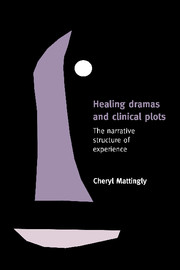Book contents
- Frontmatter
- Contents
- Preface
- Acknowledgments
- 1 Finding narrative in clinical practice
- 2 The mimetic question
- 3 The checkers game: clinical actions in quest of a narrative
- 4 Therapeutic plots
- 5 The self in narrative suspense: therapeutic plots and life stories
- 6 Some moments are more narrative than others
- 7 Therapeutic plots, healing rituals, and the creation of significant experience
- Notes
- References
- Index
2 - The mimetic question
Published online by Cambridge University Press: 05 June 2012
- Frontmatter
- Contents
- Preface
- Acknowledgments
- 1 Finding narrative in clinical practice
- 2 The mimetic question
- 3 The checkers game: clinical actions in quest of a narrative
- 4 Therapeutic plots
- 5 The self in narrative suspense: therapeutic plots and life stories
- 6 Some moments are more narrative than others
- 7 Therapeutic plots, healing rituals, and the creation of significant experience
- Notes
- References
- Index
Summary
Who could deny the power or need for narratives in understandings interpreting and communicating experience., or the “call of stories” (Coles 1989) when trying to make sense of the extraordinary and the disorienting? But there are radically different positions which explain why narrative has this power. One, a realist or mimetic stance, assumes that at some deep level there is a natural correspondence between life as lived and life as narrated. The naive version of this is that narrative simply represents experience. A second position, far more pervasive among contemporary scholars of narrative, is anti-mimetic, presuming that narrative derives its power by transforming and distorting life as lived. And further, that experience requires the transformation and distortion that narrative imposes in order to be meaningful. An important variation of this anti-mimetic stance is the performative position which contends that the significant relation between narrative and experience is not referential but emerges in the experience of the narrative as performed. The meaning is located in the event itself, the “creation of presence” (Schieffelin 1996: 59).
I offer a third position which rejects both naive realism and the variety of anti-mimetic positions now predominant. The third alternative, already suggested in Chapter 1, will be briefly outlined here and gradually developed throughout the remaining chapters of this book in the context of ethnographic material.
The realist position: narrative as imitation of action and experience
The irresistible urge to catch hold of experience by putting it in narrative form and the further urge to believe one has captured something true belongs to what is often termed the “realist” position.
- Type
- Chapter
- Information
- Healing Dramas and Clinical PlotsThe Narrative Structure of Experience, pp. 25 - 47Publisher: Cambridge University PressPrint publication year: 1998
- 1
- Cited by

